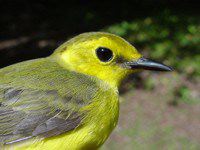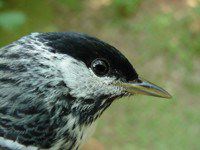YES, WE DO HAVE
WHITE-BREASTED NUTHATCHES!
As we described last week under "Other Sightings of Interest," on 29 April 2005 we netted a White-breasted Nuthatch--only our tenth-ever since we started banding at Hilton Pond Center. What was even more significant was that the bird was an adult female AND she had a well-developed brood patch--a significant expanse of bare skin on her belly. Such patches, which are edematous (swelled by fluid) and vascularized (laden with blood vessels), occur in many female birds when they begin nesting and are an optimal mechanism for transferring body heat to eggs or chicks. This brood patch was the first sign that White-breasted Nuthatches might be breeding on the property--welcome news for a locale that when we arrived in 1982 had only a few big trees dotting an otherwise-open 11 acres of grass and low shrubs. An additional implication of breeding came this week on the morning of 1 May when we caught a male nuthatch--likely the mate of our previous capture. The final evidence we needed to show that this species was reproducing locally came on 2 May when a weakly flying fledgling hit one of our nets. The only better proof would have come had we found the actual nest, but this young individual couldn't have traveled very far. Thus, we feel confident in saying that Hilton Pond Center finally has at least one breeding pair of White-breasted Nuthatches!
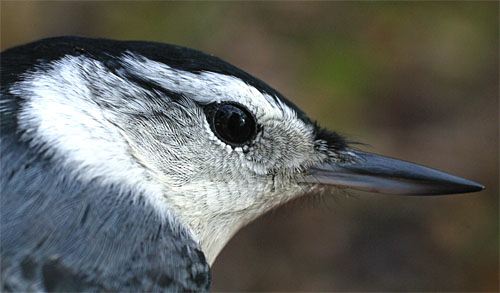
All text & photos © Hilton Pond Center
This trio of captures brought our 24-year total of banded White-breasted Nuthatches at the Center to 12, eight of which have been caught during the past five years as vegetative succession turned the property into young woodland. Since this species typically nests in an existing cavity in a mature hardwood and gleans insects from bark of the same, the increased presence of trees has enhanced the possibility that White-breasted Nuthatches would frequent our acreage. Those that we've observed locally through the years may not have nested on the property, but they certainly didn't mind partaking of our sunflower offerings in winter. 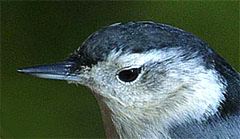 The male we caught this week was seemingly obsessed with one of our tube feeders. He continues to visit it dozens of times an hour--each time grabbing a single sunflower seed that he takes off with and "hides" in the bark crevice of a nearby tree. We seriously doubt he'll remember where all these seeds are cached, so we wouldn't be surprised to see sunflower plants sprouting from the limbs of oaks and hickories as spring unfolds. The male we caught this week was seemingly obsessed with one of our tube feeders. He continues to visit it dozens of times an hour--each time grabbing a single sunflower seed that he takes off with and "hides" in the bark crevice of a nearby tree. We seriously doubt he'll remember where all these seeds are cached, so we wouldn't be surprised to see sunflower plants sprouting from the limbs of oaks and hickories as spring unfolds.
At some locations in the eastern U.S. it's possible to sex White-breasted Nuthatches at the feeder without having to capture them.  Often the adult males have a solid black cap (top photo), while the crown of the female tends to be grayer (above right). In midwestern and western populations--which have somewhat darker bodies than our eastern birds--the crowns are essentially the same in adults of either sex. (During our graduate school days, we observed that male and female White-breasted Nuthatches in central Minnesota looked just alike and we could only differentiate them in-the-hand during breeding season when females had noticeable brood patches.) All the various color variants are the same species--Sitta carolinensis--but differences in behavior, vocalization, plumage, and location have led ornithologists to divide White-breasted Nuthatches into at least three distinct subspecies or races. Often the adult males have a solid black cap (top photo), while the crown of the female tends to be grayer (above right). In midwestern and western populations--which have somewhat darker bodies than our eastern birds--the crowns are essentially the same in adults of either sex. (During our graduate school days, we observed that male and female White-breasted Nuthatches in central Minnesota looked just alike and we could only differentiate them in-the-hand during breeding season when females had noticeable brood patches.) All the various color variants are the same species--Sitta carolinensis--but differences in behavior, vocalization, plumage, and location have led ornithologists to divide White-breasted Nuthatches into at least three distinct subspecies or races.
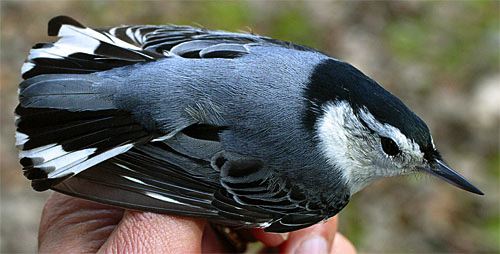
Beginning birders sometimes confuse White-breasted Nuthatches with Black-capped or Carolina Chickadees. The confusion is understandable--these birds all have dark caps, white cheeks, and gray backs--but to us there seem to be more DIS-similarities than common characters. The chickadee, for example, has a short black bill, a hint of white wing bars, pale rusty sides, an unmarked tail, and a black bib, while the White-breasted Nuthatch has a very long, two-tone black and gray bill, no wing bars, a tail with obvious white spots and rusty undertail coverts (above left and above), and a white throat, sides, and belly--the latter of which give the species its name.
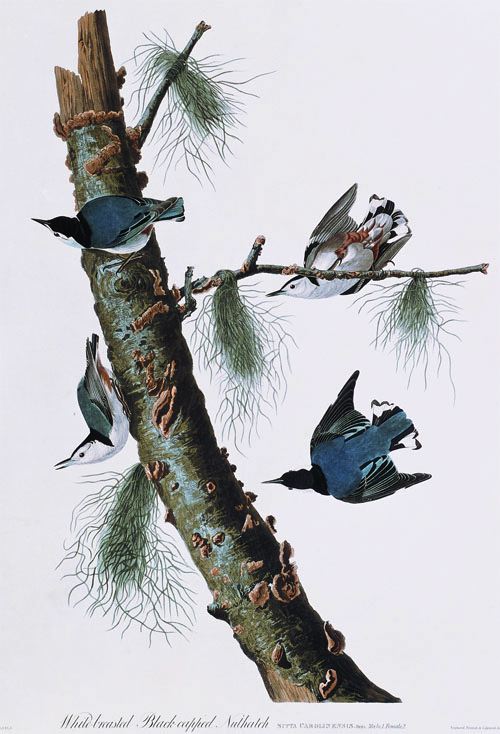
Nuthatches also exhibit an interesting behavioral trait that differentiates them from chickadees and nearly all other birds. They're bark clingers that work up and down tree trunks gleaning insects, but unlike woodpeckers that move head-up on the trunk, nuthatches go head-down--as noted in John James Audubon's rendering (above). This distinctive behavior gives the nuthatch an advantage over most of its bark-gleaning competitors in that it can look down into bark crevices from above while all the other species look mostly into openings that face downward or sideways. In addition, its long bill allows the nuthatch to reach deeper into holes than birds such as chickadees, Brown Creepers, and Black-and-white Warblers. 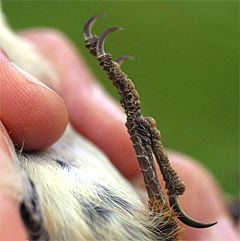
The White-breasted Nuthatch's foot (below right) is also well adapted to its habits: Long, straight toes with sharply decurved claws that enable it to hold tightly to various bark textures. It's always enjoyable to watch a couple of White-breasted Nuthatches foraging on a big White Oak, where they hop effortlessly up and down and around the rough, flaky bark while calling to each other with their nasal "yank . . . yank . . . yank."
As mentioned, White-breasted Nuthatches are cavity nesters, but they almost never excavate their own holes, preferring instead to occupy a natural opening or to sublet old housing from local woodpeckers. Occasionally they will utilize a nest box with an entry hole at least 1.25" in diameter. The female lays a relatively large number of eggs (up to ten), but we've never observed a family larger than six-- including the two adults, which apparently form long-term pair bonds. Curiously, in South Carolina the species seems to be common in the Coastal Plain and Upper Piedmont but breeds infrequently in the central part of the state.
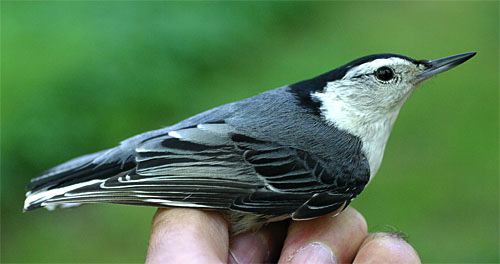
In addition to the 12 White-breasted Nuthatches we've captured around Hilton Pond since 1982, we've caught two other nuthatch species: The Red-breasted (seven have been banded) and Brown-headed (37). The former are seldom-seen winter migrants from up north, while the latter are year-round residents that occur locally in much smaller numbers since a neighboring pine plantation was logged in the mid-1990s. But that's another story and for now we're just pleased to say that yes, we DO have White-breasted Nuthatches breeding at Hilton Pond Center!
POSTSCRIPT: As mentioned, the young White-breasted Nuthatch we banded this week was not a strong flyer and couldn't have fledged very far away from where it was netted. The bird also had a lower mandible with a bright yellow base--another sure sign of a nestling or recent fledgling. Normally, we would have documented this interesting phenomenon photographically, but earlier in the day a financial and logistical catastrophe hit Hilton Pond Center when--impeded by less-than-optimal vision in our surgically repaired left eye--we tripped over a tripod to which our cherished Canon D60 single-lens reflex digital camera and 50mm macro lens were attached, sending the entire apparatus crashing hard to the ground. The lens snapped off at its base and the camera body itself was smashed inward. We, too, were crushed by the accident--especially when we learned the next day that our insurance would NOT cover replacements. We now have an old Sony Mavica camera to fall back on, but photo quality in our on-line nature installments will certainly suffer until we're able to procure another digital Canon SLR. Photos elsewhere on this page were made prior to the equipment casualty, so at least we are able to amply illustrate our "This Week" essay about White-breasted Nuthatches.
All text & photos © Hilton Pond Center
Comments or questions about this week's installment?
Please send an E-mail message to INFO.
NOTE: Be sure to scroll down for an account of all birds banded or recaptured during the week, as well as some other interesting nature notes.
"This Week at Hilton Pond" is written & photographed
by Bill Hilton Jr., executive director of
Hilton Pond Center for Piedmont Natural History.
You may wish to consult our Index of all nature topics covered since February 2000. You can also use the on-line Search Engine at the bottom of this page.
For a free, non-fattening, on-line subscription to "This Week at Hilton Pond," just send us an E-mail with SUBSCRIBE in the Subject line. Please be sure to configure your spam filter to accept E-mails from hiltonpond.org.
|


 The male we caught this week was seemingly obsessed with one of our tube feeders. He continues to visit it dozens of times an hour--each time grabbing a single sunflower seed that he takes off with and "hides" in the bark crevice of a nearby tree. We seriously doubt he'll remember where all these seeds are cached, so we wouldn't be surprised to see sunflower plants sprouting from the limbs of oaks and hickories as spring unfolds.
The male we caught this week was seemingly obsessed with one of our tube feeders. He continues to visit it dozens of times an hour--each time grabbing a single sunflower seed that he takes off with and "hides" in the bark crevice of a nearby tree. We seriously doubt he'll remember where all these seeds are cached, so we wouldn't be surprised to see sunflower plants sprouting from the limbs of oaks and hickories as spring unfolds. Often the adult males have a solid black cap (top photo), while the crown of the female tends to be grayer (above right). In midwestern and western populations--which have somewhat darker bodies than our eastern birds--the crowns are essentially the same in adults of either sex. (During our graduate school days, we observed that male and female White-breasted Nuthatches in central Minnesota looked just alike and we could only differentiate them in-the-hand during breeding season when females had noticeable brood patches.) All the various color variants are the same species--Sitta carolinensis--but differences in behavior, vocalization, plumage, and location have led ornithologists to divide White-breasted Nuthatches into at least three distinct subspecies or races.
Often the adult males have a solid black cap (top photo), while the crown of the female tends to be grayer (above right). In midwestern and western populations--which have somewhat darker bodies than our eastern birds--the crowns are essentially the same in adults of either sex. (During our graduate school days, we observed that male and female White-breasted Nuthatches in central Minnesota looked just alike and we could only differentiate them in-the-hand during breeding season when females had noticeable brood patches.) All the various color variants are the same species--Sitta carolinensis--but differences in behavior, vocalization, plumage, and location have led ornithologists to divide White-breasted Nuthatches into at least three distinct subspecies or races.





 Please report your
Please report your